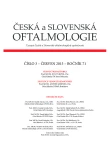-
Medical journals
- Career
Intrinsically Photosensitive Retinal Ganglion Cells
Authors: K. Skorkovská 1; Š. Skorkovská 2
Authors‘ workplace: Klinika nemocí očních a optometrie, Lékařská fakulta Masarykovy univerzity Fakultní nemocnice u sv. Anny, Brno přednosta doc. MUDr. Svatopluk Synek, CSc. 1; Evropská oční klinika Lexum, Bezručova 22, Brno 2
Published in: Čes. a slov. Oftal., 71, 2015, No. 3, p. 144-149
Category: Original Article
Overview
Recently discovered intrinsically photosensitive melanopsin-containing retinal ganglion cells contribute to circadian photoentrainment and pupillary constriction; recent works have also brought new evidence for their accessory role in the visual system in humans. Pupil light reaction driven by individual photoreceptors can be isolated by means of the so called chromatic pupillography. The use of chromatic stimuli to elicit different pupillary responses may become an objective clinical pupil test in the detection of retinal diseases and in assessing new therapeutic approaches particularly in hereditary retinal degenerations like retinitis pigmentosa. In advanced stages of disease, the pupil light reaction is even more sensitive than standard electroretinography for detecting residual levels of photoreceptor activity. This review summarizes current knowledge on intrinsically photosensitive retinal cells and highlights its possible implications for clinical practice.
Key words:
retinal ganglion cells, melanopsin, pupillography, retinitis pigmentosa
Sources
1. Bailes, H.J., Lucas, R.J.: Melanopsin and inner retinal photoreception. Cell Mol Life Sci, 67; 2010 : 99–111.
2. Berson, D.M., Dunn, F.A., Takao, M.: Phototransduction by retinal ganglion cells that set the circadian clock. Science, 295; 2002 : 1070–1073.
3. Dacey, D.M., Liao, H.W., Peterson, B.B. et al.: Melanopsin-expressing ganglion cells in primate retina signal colour and irradiance and project to the LGN. Nature, 433; 2005 : 749–754.
4. Do, M.T., Kang, S.H., Xue, T. et al.: Photon capture and signalling by melanopsin retinal ganglion cells. Nature, 457; 2009 : 281–287.
5. Drouyer, E., Dkhissi-Benyahya, O., Chiquet, C. et al.: Glaucoma alters the circadian timing system. PLoS One, 3; 2008: e3931.
6. Ecker, J.L., Dumitrescu, O.N., Wong, K.Y. et al.: Melanopsin-expressing retinal ganglion-cell photoreceptors: cellular diversity and role in pattern vision. Neuron, 67; 2010 : 49–60.
7. Esquiva, G., Lax, P., Cuenca, N.: Impairment of intrinsically photosensitive retinal ganglion cells associated with late stages of retinal degeneration. Invest Ophthalmol Vis Sci, 54(7); 2013 : 4605–18.
8. Feigl, B., Mattes, D., Thomas, R. et al.: Intrinsically photosensitive (melanopsin) retinal ganglion cell function in glaucoma. Invest Ophthalmol Vis Sci, 52; 2011 : 4362–4367.
9. Hattar, S., Liao, H.W., Tako, M. et al.: Melanopsin-containing retinal ganglion cells: architecture, projections, and intrinsic photosensitivity. Science, 295; 2002 : 1065–1070.
10.Kankipati, L., Girkin, C.A., Gamlin, P.D.: Postillumination pupil response in subjects without ocular disease. Invest Ophthalmol Vis Sci, 51; 2010 : 2764–2769.
11.Kankipati, L., Girkin, C.A., Gamlin, P.D.: The post-illumination pupil response is reduced in glaucoma patients. Invest Ophthalmol Vis Sci, 52; 2011 : 2287–2292.
12. Kardon, R., Anderson, S.C., Damarjian, T.G. et al.: Chromatic pupil responses: preferential activation of the melanopsin-mediated versus outer photoreceptor-mediated pupil light reflex. Ophthalmology, 116; 2009 : 1564–1573.
13. Kardon, R.H., Anderson, S.C., Damarjian, T.G. et al.: Chromatic pupillometry in patients with retinitis pigmentosa. Ophthalmology, 118; 2011 : 376–381.
14. Kawasaki, A., Collomb, S., Léon, L. et al.: Pupil responses derived from outer and inner retinal photoreception are normal in patients with hereditary optic neuropathy. Exp Eye Res, 120; 2014 : 161–166.
15.Kawasaki, A., Crippa, S.V., Kardon, R., Leon, L., Hamel, C.: Characterization of pupil responses to blue and red light stimuli in autosomal dominant retinitis pigmentosa due to NR2E3 mutation. Invest Ophthalmol Vis Sci, 53; 2012 : 5562–5569.
16.Kawasaki, A., Kardon, R.H.: Intrinsically photosensitive retinal ganglion cells. J Neuro-Ophthalmol, 27(3); 2007 : 195–204.
17. La Morgia, C., Ross-Cisneros, F.N., Sadun, A.A. et al.: Melanopsin retinal ganglion cells are resistant to neurodegeneration in mitochondrial optic neuropathies. Brain, 133; 2010 : 2426–2438.
18. Lucas, R.J., Douglas, R.H., Foster, R.G.: Characterization of an ocular photopigment capable of driving pupillary constriction in mice. Nat Neurosci, 4; 2001 : 621–626.
19. Münch, M., Kawasaki, A.: Intrinsically photosensitive retinal ganglion cells; classification, function and clinical implications. Curr Opin Neurol, 26; 2013 : 45–51.
20. Schmidt, T.M., Chen, S., Hattar, S.: Intrinsically photosensitive retinal ganglion cells: many subtypes, diverse functions. Trends Neurosci, 34(11); 2011 : 572–580.
21. Skorkovská, K., Maeda, F., Kelbsch, C. et al.: Pupilární reakce na barevné podněty. Cesk Slov Neurol N, 77; 2014 : 334–338.
22. Wilhelm, B.J.: Das Auge der Inneren Uhr – Pupillenforschung in neuem Licht. Klin Monatsbl Augenheilkd, 227; 2010 : 840–844.
Labels
Ophthalmology
Article was published inCzech and Slovak Ophthalmology

2015 Issue 3-
All articles in this issue
- Functional Magnetic Resonance Imaging in Selected Eye Diseases
- Stereotactic Rediosurgery for Uveal Melanoma; Postradiation Complications
- Intrinsically Photosensitive Retinal Ganglion Cells
- Malignant Choroidal Melanoma in T4 Orbital Stage; Prosthesis of the Orbit
- Treatment of Keratoconus with Corneal Cross-linking – Results and Complications in 2 Years Follow-up
- Surgical Treatment of the Idiopathic Macular Hole by Means of 25-Gauge Pars Plana Vitrectomy with the Peeling of the Internal Limiting Membrane Assisted by Brilliant Blue and Gas Tamponade
- Multifocal Vitelliform Retinal Lesion
- Czech and Slovak Ophthalmology
- Journal archive
- Current issue
- Online only
- About the journal
Most read in this issue- Intrinsically Photosensitive Retinal Ganglion Cells
- Functional Magnetic Resonance Imaging in Selected Eye Diseases
- Surgical Treatment of the Idiopathic Macular Hole by Means of 25-Gauge Pars Plana Vitrectomy with the Peeling of the Internal Limiting Membrane Assisted by Brilliant Blue and Gas Tamponade
- Malignant Choroidal Melanoma in T4 Orbital Stage; Prosthesis of the Orbit
Login#ADS_BOTTOM_SCRIPTS#Forgotten passwordEnter the email address that you registered with. We will send you instructions on how to set a new password.
- Career

